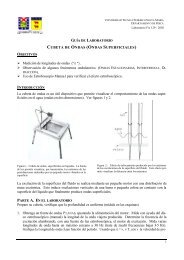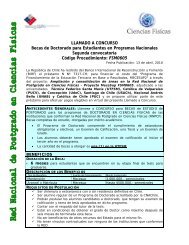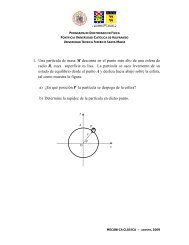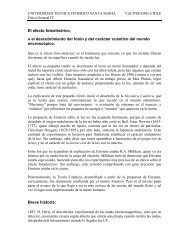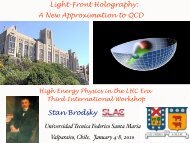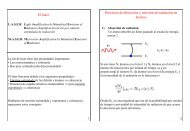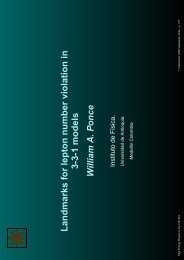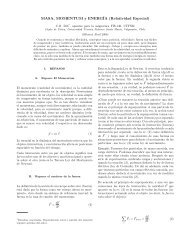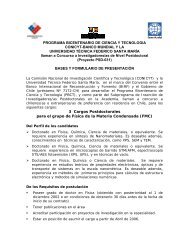Aca - Departamento de Física - Universidad Técnica Federico Santa ...
Aca - Departamento de Física - Universidad Técnica Federico Santa ...
Aca - Departamento de Física - Universidad Técnica Federico Santa ...
You also want an ePaper? Increase the reach of your titles
YUMPU automatically turns print PDFs into web optimized ePapers that Google loves.
V Encuentro Sud Americano <strong>de</strong> Colisiones Inelásticas en la Materia<br />
Energy-loss spectra measured for some<br />
crystal azimuthal directions are shown in<br />
Figs.2(a,b) and 3(a,b) for hydrogen and<br />
fluorine inci<strong>de</strong>nt ions. In Figs.2(a,b), the<br />
Full-Width-at-Half-Maximum (FWHM) of<br />
scattered beam is consi<strong>de</strong>rably broad and<br />
seems to have a large energy loss tail. The<br />
most striking difference is observed for F<br />
ions scattering with an azimuthal angle of<br />
70.5°, where a double peak structure is<br />
observed in Figs. 3(a,b) for 4 keV but<br />
disappears for 1 keV.<br />
Intensity<br />
relative intensity<br />
150<br />
100<br />
50<br />
0<br />
0 200 400 600 800 1000 1200<br />
1.1<br />
1.0<br />
0.9 (b)<br />
simulation<br />
0.8<br />
experiment<br />
0.7<br />
0.6<br />
1 keV H + -Au(110)<br />
0.5<br />
0.4<br />
azimuthal angle 0 0.3<br />
0.2<br />
0.1<br />
0.0<br />
-50 0 50 100 150 200 250 300 350<br />
Fig. 2. (a) and (b) Energy loss spectra of 4 and 1 keV H +<br />
ions scattered off a Au (110) surface along the indicated<br />
azimuthal direction of 0 0 respectively<br />
intensity<br />
200<br />
150<br />
100<br />
50<br />
(a)<br />
(a)<br />
energy Loss (eV)<br />
experiment<br />
selected total<br />
selected on top of the surface<br />
selected bellow the first layer<br />
4 keV H + -Au(110)<br />
azimuthal angle 0 0<br />
experiment<br />
selected on top of the surface<br />
selected bellow the first layer<br />
4 keV F - -Au(110)<br />
azimuthal angle 70.5 0<br />
electron capture again leads to F - formation.<br />
Here we introduce neutralization<br />
empirically, using theoretical treatments as<br />
a gui<strong>de</strong>line. Electron transfer processes<br />
occur over the characteristic distances of<br />
around Z F =5.0 atomic units from the image<br />
plane for fluorine. A similar range of<br />
distances is assumed for Auger<br />
neutralization of hydrogen. Image charge<br />
effects are “switched off” for neutralized<br />
particles.<br />
The simulated [1, 2] energy loss spectra<br />
are also shown in Figs.2(a,b) and 3(a,b),<br />
which are in good agreement with the<br />
experiment. We furthermore observed a<br />
splitting of the energy loss spectrum into<br />
two components due to two different types<br />
of the trajectory, as shown in Figs.2(c) and<br />
3(c). The trajectory a results from scattering<br />
from the most top layer of the surface and b<br />
from subsurface has a longer effective<br />
length.<br />
Energy-loss spectra of hydrogen and<br />
fluorine ions scattered off a Au (110)<br />
single-crystal surface in grazing scattering<br />
conditions were reported for various<br />
orientations of the surface. We presented<br />
simulations which take into account the<br />
corrugation of the electron <strong>de</strong>nsity<br />
above the surface are in good agreement<br />
with the experimental data.<br />
relative intensity<br />
1.0<br />
0.8<br />
0.6<br />
0.4<br />
0.2<br />
0<br />
0 50 100 150 200 250 300 350<br />
(b)<br />
simulation<br />
experiment<br />
1 keV F - -Au(110)<br />
azimuthal angle 70.5 0<br />
0.0<br />
-20 0 20 40 60 80 100<br />
energy loss (eV)<br />
Fig. 3. (a) and (b) Energy loss spectrum of 4 and 1 keV F -<br />
scattering along the 70.5° direction for Au(110)<br />
respectively.<br />
In <strong>de</strong>scribing H + and F - scattering on Au<br />
one should correctly <strong>de</strong>scribe the effect of<br />
the image potential. This implies a correct<br />
<strong>de</strong>scription of electron transfer processesresonant<br />
and Auger neutralization on the<br />
incoming and outgoing path of the<br />
trajectory. We consi<strong>de</strong>r H + neutralization in<br />
the incoming path and in case of F - we<br />
consi<strong>de</strong>r that at large distances (Z> Z F )<br />
when the affinity level is above the Fermi<br />
level electron loss occurs leading to F°<br />
formation, while at small distances, when<br />
the F - level lies below the Fermi level<br />
References<br />
[1] Valdés J E, Vargas P, Celedón C,<br />
Sanchez E, Guillemot L and<br />
Esaulov V A 2008 Phys. Rev. A<br />
78 32902<br />
[2] Valdés J E, Vargas P, Guillemot L<br />
and Esaulov V A 2007 Nucl.<br />
Inst. And Methods B 256 81<br />
98 Valparaíso, Chile



